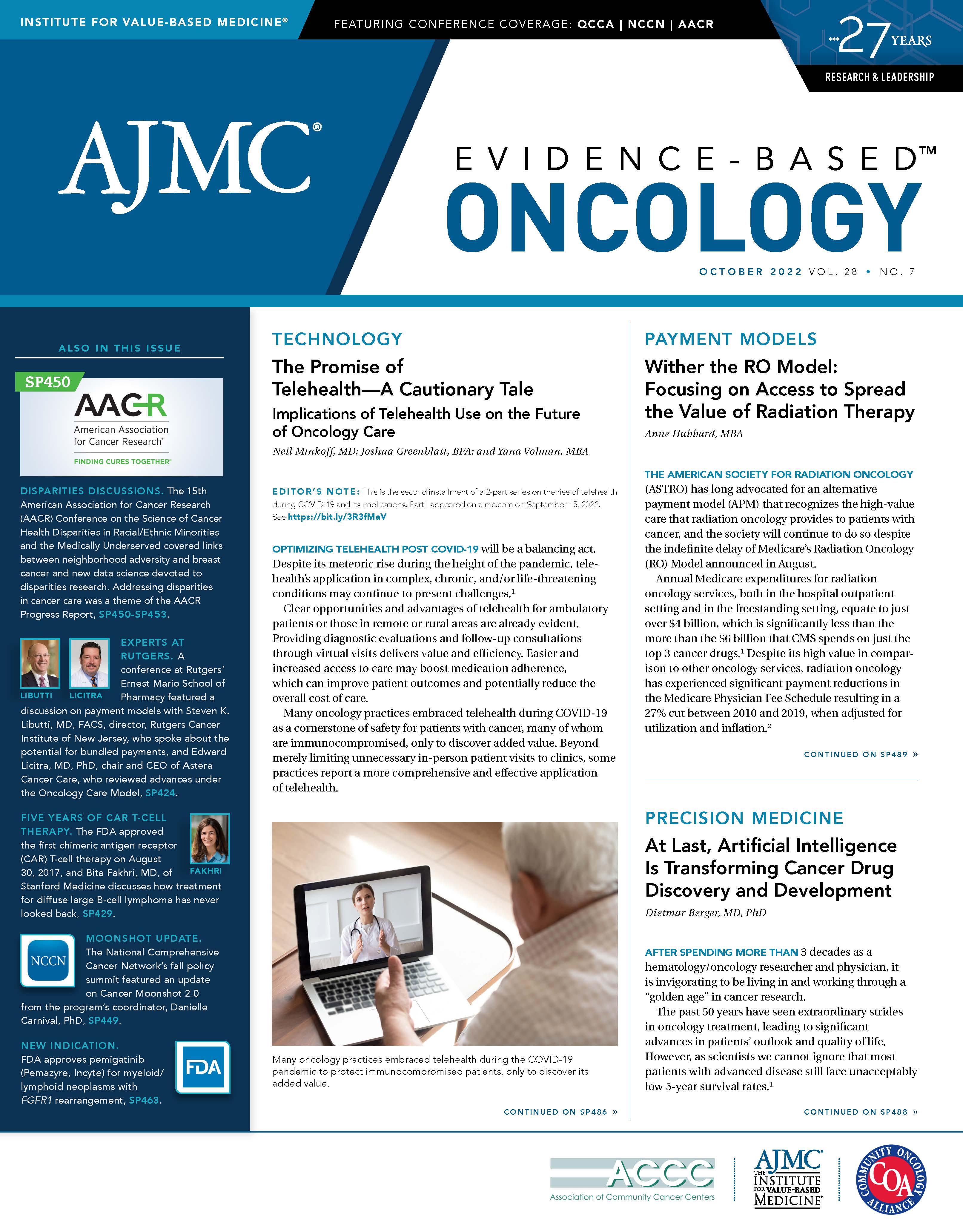Publication
Article
Evidence-Based Oncology
At Last, Artificial Intelligence Is Transforming Cancer Drug Discovery and Development
Author(s):
After spending more than 3 decades as a hematology/oncology researcher and physician, it is invigorating to be living in and working through a “golden age” in cancer research.
The past 50 years have seen extraordinary strides in oncology treatment, leading to significant advances in patients’ outlook and quality of life.
However, as scientists we cannot ignore that most patients with advanced disease still face unacceptably low 5-year survival rates.1
Now, harnessing a growing body of next-generation technologies will accelerate the industry as we have never seen before, with the potential to design and develop novel medicines that could extend and save lives.
Among the most exciting of these technologies are approaches that combine artificial intelligence (AI) and machine learning to discover and develop better cancer-fighting molecules in a fraction of previous timelines.
I have spent much of my career working to advance medicines that can shrink and destroy tumors while maintaining an acceptable safety profile.
Advances in the study of human biology have transformed our understanding of tumor growth, the immune response, molecular resistance mechanisms, and individual patient differences at the molecular level. This is opening new doors for oncology researchers to use AI and machine learning to understand the 3-dimensional structure of proteins and target them with greater precision.
Recognizing this promise, Sanofi has invested in research collaborations that are focused on leveraging these new technology platforms, ones that have the potential to transform capabilities in target identification, molecule discovery, and clinical development, for both cancer and immune-mediated diseases. The goal is to shorten timelines and design higher-quality, more precisely targeted medicines for the patients who will benefit most.2,3
With time, using AI to discover and design better medicines could improve success rates for early-stage assets and accelerate long developmental timelines. In turn, these efficiencies hold the potential to upend today’s pharmacoeconomic model as new treatments reach the market.4
The benefits of investment in AI and machine learning extend to the process of drug development in other important ways:
Data-driven strategy and decisions. We can use AI and machine learning to understand the current standards of care, mining information from genomic and transcriptomic databases to assist with tumor characterization to understand the best indications where we can apply our medicines.
Innovative study designs, modeling and simulation, decentralized clinical trials, process automation, and clinical digital data flow are increasingly used to streamline and accelerate our clinical development. AI holds great promise to initiate more effective clinical studies with a higher probability of success in patient populations chosen with more scientific rigor based on what we know about their molecular makeup.4
Identification of combinations. AI and machine learning can enable us to overlay various data sets focused on mechanism of action and tumor subtype to identify correlations that confer rational combinations. This can help us identify which patients stand a better chance to benefit, helping to minimize the trial and error of conventional, empirical research.4,5
Digital technologies and biomarkers. Innovations in digital technologies are making it possible for the pharmaceutical industry to generate millions of data points over the course of a clinical trial. AI and machine learning can also help make sense of the data generated and tailor potential therapies that improve on novel end points, such as patient mobility, and digital biomarkers.6
Cancer is too great a challenge to tackle alone. I am proud to be involved in meaningful work in collaboration with innovative minds across our industry to accelerate discovery and clinical development on behalf of patients with the goal of designing higher quality medicines utilizing these exciting technologies. The future is upon us, and the possibilities are enormous.
Author Information
Dietmar Berger, MD, PhD, is chief medical officer and global head of development at Sanofi.
References
1. Cancer facts and figures: 2021. American Cancer Society. Accessed July 2022. https://www.cancer.org/content/dam/cancer-org/research/cancer-facts-and-statistics/annualcancer-facts-and-figures/2021/cancer-facts-and-figures-2021.pdf
2. Sanofi invests $180 million equity in Owkin’s artificial intelligence and federated learning to advance oncology pipeline. News release. Sanofi; November 18, 2021. Accessed August 14, 2022. https://www.sanofi.com/en/media-room/press-releases/2021/2021-11-18-06-30-00-2336966
3. Exscientia and Sanofi establish strategic research collaboration to develop AI-driven pipeline of precision-engineered medicines. News release. Sanofi; January 7, 2022. Accessed August 14, 2022. https://www.sanofi.com/en/media-room/press-releases/2022/2022-01-07-06-00-00-2362917
4. Farina E, Nabhen JJ, Dacoregio MI, Batalini F, Moraes FY. An overview of artificial intelligence in oncology. Future Sci OA. 2022;8(4):FSO787. doi:10.2144/fsoa-2021-0074
5. Tsigelny IF. Artificial intelligence in drug combination therapy. Brief Bioinform. 2019;20(4):1434-1448. doi:10.1093/bib/bby004
6. Low CA. Harnessing consumer smartphone and wearable sensors for clinical cancer research. NPJ Digit Med. 2020;3:140. doi:10.1038/s41746-020-00351-x



